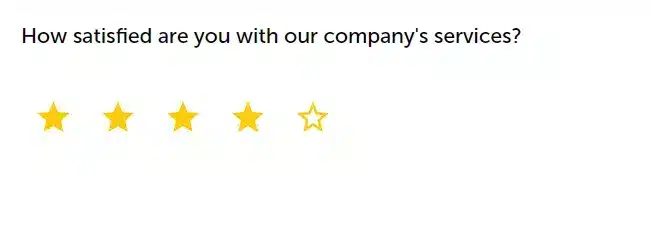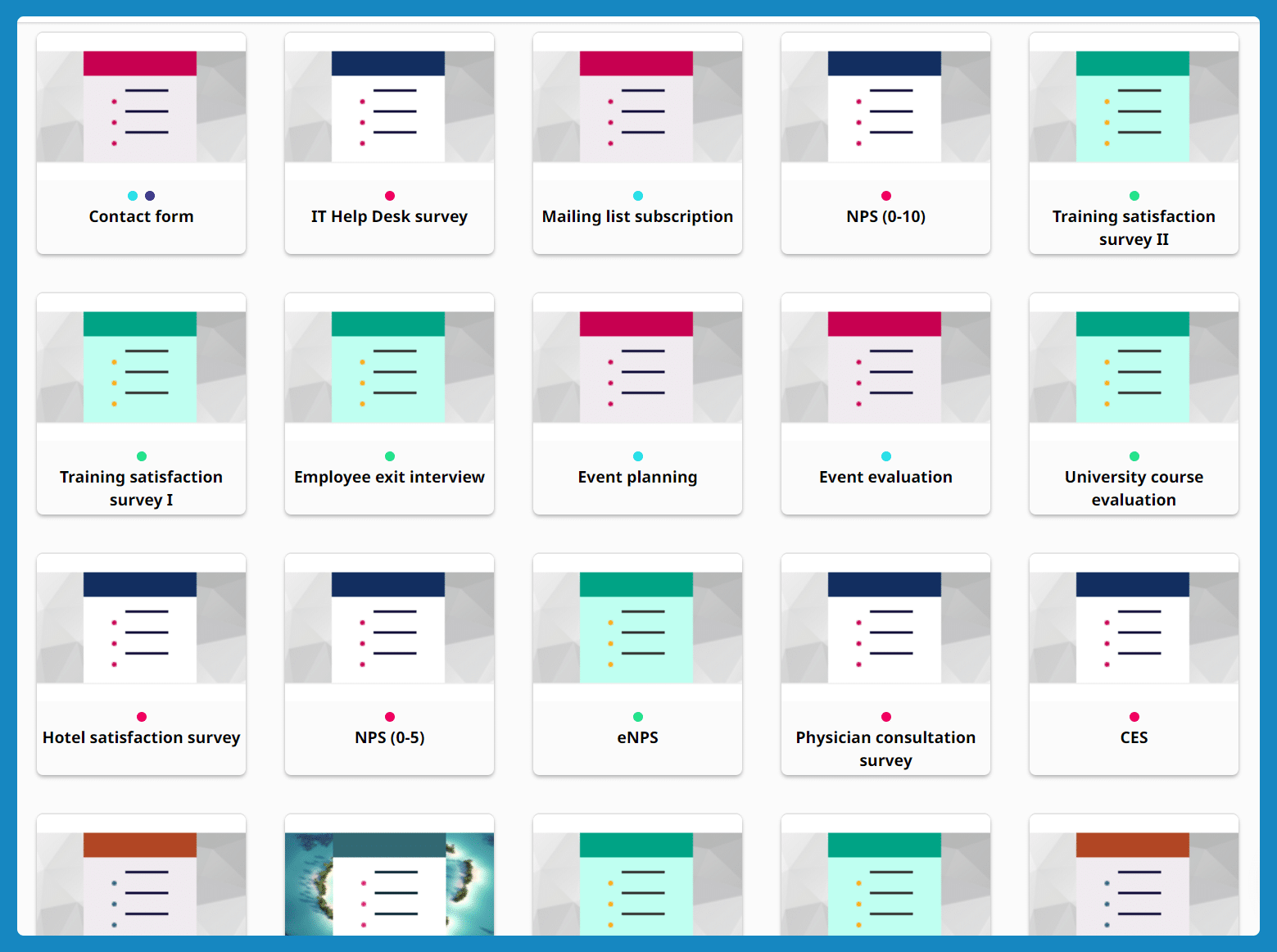If you’ve never considered all the poll questions available, you’re in for a treat!
The right poll can unlock many insights – figuring out preferences with multiple choice questions, exploring nuanced opinions through Likert scales, and more.
Whatever the reason, for business, study, or fun, understanding the different types of poll questions can transform how you gather information and engage your audience.
Poll questions types

Let’s break them down into types:
#1 Multiple choice questions
When engaging your audience, no matter if it’s in professional settings like team meetings or more casual scenarios among friends, multiple choice questions stand out as both versatile and insightful.
Making these polls is not just informative but irresistibly fun and original.
Fun poll questions
Boost the mood with lighthearted queries such as “What’s your favorite dessert?” or “Which Harry Potter character would be your best friend?”
The fun poll ideas serve as great icebreakers and add a personal touch. They may everyone to share a bit more about themselves.
Get to know preferences
Ask about the last movie someone watched or their favorite genre of music. It’s a fantastic way to see common interests and spark engaging discussions.
Discover personal insights
“What was your favorite thing to do as a child?” or “Describe your dream job.” Such questions invite participants to share personal stories and aspirations as they foster a deeper connection among colleagues and friends.
Fun vs. function
Incorporate questions that balance light-hearted fun with functional insights.
For instance, “Do you prefer working early in the morning or late at night?” can reveal much about a person’s productivity habits while keeping the tone upbeat.
Engage with hypotheticals
“If you could have one superpower, what would it be?” – it opens up a world of creativity and discussion, and makes your poll memorable and engaging.
Cultural picks
Questions like “Which TV show could you re-watch forever?” or “Which Harry Potter house do you see yourself in?” tap into popular culture. Participants can bond over shared interests.
Feedback loop
Though not directly seeking feedback, asking for preferences on topics relevant to your group (like best pizza places or optimal SaaS pricing strategies for software as a service companies) can provide insights in a non-formal manner.
#2 Rating scale questions
Rating scale questions transform simple polls into rich sources of insights – they blend the analytical with the personal.
You’re not just gathering data here. You’re trying to understand preferences, perceptions, and experiences on a nuanced level.
Let’s explore how to leverage rating scale questions for both depth and engagement.
Gauge customer satisfaction
“On a scale of 1-10, how satisfied are you with our latest tech invention?”

The classic application of rating scales can provide a clear measure of customer reactions. It helps to pinpoint areas for improvement or celebrate successes.
📚 Read: How to Create Good Customer Satisfaction Survey?
Measure energy levels
“Rate your energy level today on a scale from 1-5.”
Such questions can give immediate feedback on team morale or individual readiness. They’re excellent for kickoff meetings or to close a productive Zoom call.
Assess preferences
“How much do you enjoy the latest TV show on a scale of 1-10?” or “Rate your desire to visit the Sahara Desert from 1-5.”
Get to know the personal tastes with questions like these. They can reveal much about an individual’s preferences and aspirations, such as their dream holiday destination or favorite type of movie.
First impressions count
“Rate your first impression of our new free account feature from 1-10.”
First impressions can be telling. Rating scale questions in this context gives immediate and valuable feedback on new initiatives or products.
Understand lifestyle choices
“Are you more of an early bird or a night owl? Rate from 1 (purely early bird) to 5 (exclusively night owl).”
Such queries provide a glimpse into lifestyles and habits. It’s particularly useful in planning team schedules or activities.
Explore life experiences
“How fondly do you remember your favorite childhood memory? Rate from 1 to 10.”
They’re reflective questions that can elicit emotional responses and foster deeper connections among colleagues and friends.
Predict future trends
“On a scale from 1-10, how important do you think the next big tech invention will be for our industry in the next quarter?”
Use rating scales to collect opinions on future trends, and provide strategic insights.
#3 Open-ended questions
Open-ended questions are the gateway to deeper understanding and richer feedback in any survey or poll.
Unlike multiple-choice or rating scale questions, open-ended ones invite respondents to share their thoughts, feelings, and stories in their own words. They offer unlimited possibilities for insights.
Here’s how to craft and use these questions, tapping into their vast potential.
Fostering dialogue and reflection
Open-ended questions encourage respondents to talk and discuss more freely. For instance, questions:
“What is one thing you wish to change about our product?” or “Describe your favorite way to relax after a tough week”
They can trigger detailed responses that reveal underlying values, preferences, and experiences.
Gathering rich feedback
Instead of limiting responses to a predetermined set of answers, you allow for a broader range of feedback.
“What was your impression of the best tech invention this year?” invites a variety of perspectives, as it offers insights that might not emerge from more structured question types.
Creating engaging content
When looking to create content that resonates such as an article or a blog post, you may learn from top-performing campaigns that open-ended questions can provide authentic material.
Asking participants to describe their favorite color and why, for instance, can yield vivid stories and opinions that enrich your content.
Exploring complex topics
Some topics are too complex for simple yes/no or two possible answers.
Questions like “How has the food you eat changed over the past week, and what influenced these changes?” can unpack trends and decisions behind seemingly mundane choices.
Encouraging personal stories
“What’s the story behind your decision on how many kids to have?” – this type of question can prompt personal narratives that offer a glimpse into the decision-making processes, values, and cultural norms of individuals.
Identifying trends and patterns
When analyzing survey responses collectively, patterns can emerge from the qualitative data provided by open-ended questions. The insights can inform future strategies, poll questions, and discussion topics.
#4 Ranking questions
The give a dynamic approach to surveys and polls. Raking questions allow participants to prioritize their preferences, opinions, and values.
Ask respondents to order a list of items or concepts from most to least important (or preferred). These questions can unveil nuanced insights into what truly matters to your audience.
Let’s delve into the art of formulating ranking questions and how they can strengthen your data collection strategies.
Prioritizing features or services
Use ranking questions to directly gather feedback on what aspects of your product or service are most valued by your customers.
For example, “Rank the following features of our app from most important to least important.”
The question can guide product development and improvement efforts. You can be sure resources are allocated to what users care about the most.
Understanding consumer preferences
A question like, “Rank your favorite types of cuisine when dining out,” not only collects valuable data but also engages respondents – you prompt them to consider their personal tastes and experiences.
Evaluating decision factors
In more complex decision-making processes, ranking questions can clarify the criteria people use.
Asking, “What factors do you consider when choosing a vacation destination? Rank them in order of importance,” can provide insights into consumer behavior and marketing strategy alignment.
‘Would You Rather’ with a twist
Bring the spirit of “would you rather” into ranking questions for a light-hearted yet informative approach.
For instance, “Rank these hypothetical vacation spots you would rather visit, from most to least preferred,” mixes entertainment with valuable insights into dream destinations.
Insight into daily preferences
For more everyday contexts, ranking questions can shed light on simple preferences and habits.
“Rank these activities based on how you prefer to spend your rest day,” helps understand lifestyle choices and can inform content creation, event planning, or product offerings tailored to audience lifestyles.
#5 Dichotomous questions
Dichotomous questions stand out for their simplicity and directness. They offer a straightforward approach to collect data.
The questions require respondents to choose between two possible answers, such as “Yes” or “No,” “True” or “False,” making them a staple for researchers who gather clear, concise feedback.
See why dichotomous questions can be among the best poll questions and how to use them for better results.
Clarity and speed
The main advantage of dichotomous questions is their ability to simplify complex topics into digestible choices. They give quick and easy responses, for instance “Have you ever traveled outside of your home country?”
This clarity is especially valuable in situations where you need to make fast, informed decisions based on survey questions responses.
High response rates
Due to their simplicity, these questions often yield higher response rates, like “Do you own a smartphone?”
Participants are more likely to answer when they don’t have to ponder over multiple options or compose detailed responses. It makes dichotomous questions a good poll strategy for engaging a wide audience.
Ease of analysis
The data collected from dichotomous questions is straightforward to analyze. They provide quick feedback on audience opinions and behaviors.
Gauging interest in a new product feature? Assessing agreement with a statement? The binary nature of these responses makes for efficient data processing.
📚 Read: How to Analyze Survey Data: Best Practices.
Creating effective dichotomous questions
Ensure they are precisely worded to avoid ambiguity. Each question should be framed so that it can be answered definitively with one of the two provided options. You eliminate any potential for confusion, then.
Strategic implementation
While dichotomous questions are interesting and valuable, they are best used as part of a broader survey strategy.
They can serve as gateways into more complex topics or be used to segment respondents based on preliminary interest or opinions.
For instance, an initial “Yes” or “No” question can lead to more detailed follow-up questions tailored to the respondent’s expressed interest.
Balancing depth with brevity
Despite their strengths, it’s important to balance the use of dichotomous questions with other types of survey questions that allow for more nuanced responses.
While you benefit from the simplicity and clarity of dichotomous data, you also leave room for depth and detail where necessary.
#6 Likert scale questions
Likert scale questions, a staple in both formal research and informal polls, stand out for their nuanced approach to capturing opinions and preferences.
They give a range of options that typically span from “strongly disagree” to “strongly agree,” and allow participants to express the intensity of their feelings or agreement levels. You’ll get richer data than mere yes/no answers.

Understanding customer satisfaction
Likert scale questions can offer a detailed view of how consumers feel about various aspects of their product or service.
Questions like, “How satisfied are you with the customer service you received?” allow customers to provide feedback that is more granular and actionable.
Exploring team preferences
In a team environment, understanding collective preferences or opinions is crucial for harmony and productivity.
Likert scale questions can be used to find a team’s favorite way to communicate, manage tasks, or even decide on team-building activities.
For instance, “On a scale from 1 to 5, how much do you prefer in-person meetings over virtual ones?”
Facilitating engaging polls
When looking to create interesting polls for social media or community engagement, Likert scale questions can make for fun poll questions.
No matter if it’s about preferences for types of food, work-life balance, or favorite leisure activities, these questions encourage participants to talk and share their opinions, fostering a sense of community and engagement.
Comparing past and present
Likert scales can be particularly helpful in measuring changes in attitudes or behaviors over time.
Asking participants to rate their current view or behavior against their past experiences can uncover trends and shifts in opinion, which can be useful in longitudinal studies or feedback cycles.
Encouraging thoughtful responses
Unlike binary two possible answers questions, Likert scales encourage respondents to think more deeply about their responses. They can lead to more thoughtful, reflective answers, and richer data for analysis.
More examples of Likert Scale Questions:
- “How likely are you to recommend our service to a friend or colleague?”
- “To what extent do you agree that our new product meets your needs?”
- “How often do you use our mobile app in your daily routine?”
📚 Read: 10 Tricks to Help You Build Better Surveys.
Use SurveyLab for more powerful polls!
Are you planning to create online polls? Use SurveyLab for easy creating, sharing, and analyzing the outcomes.
It’s online surveying software with plenty of question types that you can incorporate into your poll. What’s even better, creating one is a snap, and thanks to many templates, you can prepare your poll with no effort.

Here’s more about what Surveylab can do. It:
- supports surveys on any device, including PCs, tablets, and smartphones
- offers customization options for survey branding, including logos and themes
- enables the collection of responses from multiple channels like Email, SMS, and social media
- provides real-time, graphical, and on-demand report generation for quick analysis
- features include branching, skip logic, and multi-language support
- allows integration with various CRM and helpdesk platforms
- comes with high security with SSL/HTTPS encryption and GDPR compliance
Give SurveyLab a try for a quick survey creation experience!
Conclusion
Creating good poll questions is both an art and a science is super important for gathering meaningful data, engaging participants, and uncovering deep insights.
Whether you use multiple-choice, rating scale, open-ended, ranking, dichotomous, or Likert scale questions, the key is to select the question type that best suits your objectives.
Each format has unique strengths, from the straightforwardness of dichotomous questions to the nuanced responses elicited by Likert scales.
Design your polls and surveys around these diverse question types to better customer satisfaction, promote team collaboration, and drive insightful discussions.
Now, armed with the knowledge of how to craft effective questions for every need, and the tool for that, it’s your turn to create polls that not only capture attention but also provide valuable feedback and data.
Sign up for SurveyLab, and create impactful polls.
Good luck!
FAQ on types of poll questions
They quickly identify preferences and make gathering diverse opinions from groups easy, whether in meetings or social gatherings.
They allow precise measurement of feelings or satisfaction levels on a numerical scale, and provide clarity and detail.
Open-ended questions invite in-depth responses that reveal unique insights and personal stories that other question types might miss.
Ranking questions clarify priorities by asking participants to order items or ideas from most to least important.
You can assess the intensity of responses on a scale from strong agreement to strong disagreement. It enriches the data collected beyond simple choices.

Leave a Message
You must be logged in to post a comment.